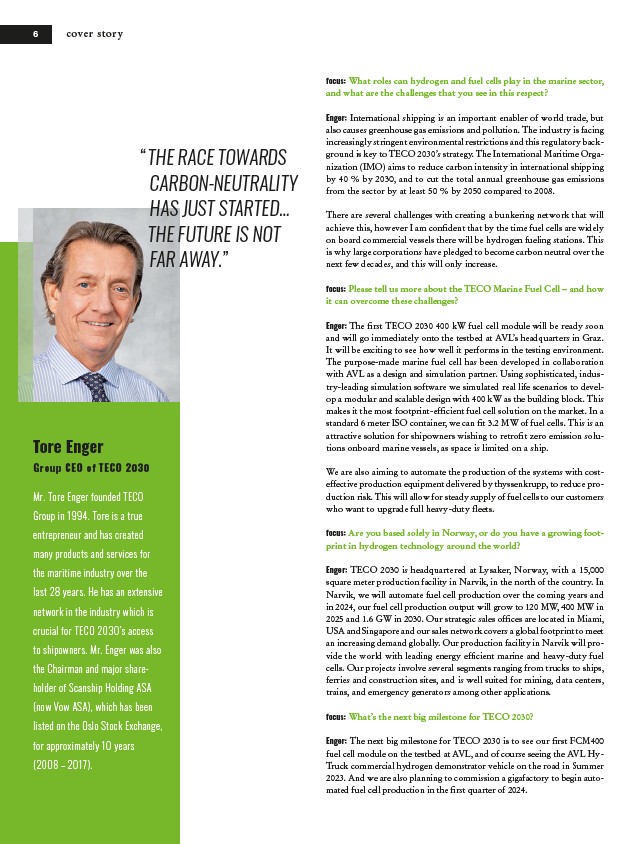
6 cover story
focus: What roles can hydrogen and fuel cells play in the marine sector,
and what are the challenges that you see in this respect?
Enger: International shipping is an important enabler of world trade, but
also causes greenhouse gas emissions and pollution. The industry is facing
increasingly stringent environmental restrictions and this regulatory background
is key to TECO 2030’s strategy. The International Maritime Organization
(IMO) aims to reduce carbon intensity in international shipping
by 40 % by 2030, and to cut the total annual greenhouse gas emissions
from the sector by at least 50 % by 2050 compared to 2008.
There are several challenges with creating a bunkering network that will
achieve this, however I am confident that by the time fuel cells are widely
on board commercial vessels there will be hydrogen fueling stations. This
is why large corporations have pledged to become carbon neutral over the
next few decades, and this will only increase.
focus: Please tell us more about the TECO Marine
Fuel Cell – and how
it can overcome these challenges?
Enger: The first TECO 2030 400 kW fuel cell module will be ready soon
and will go immediately onto the testbed at AVL’s headquarters in Graz.
It will be exciting to see how well it performs in the testing environment.
The purpose-made marine fuel cell has been developed in collaboration
with AVL as a design and simulation partner. Using sophisticated, industry
leading simulation software we simulated real life scenarios to develop
a modular and scalable design with 400 kW as the building block. This
makes it the most footprint-efficient fuel cell solution on the market. In a
standard 6 meter ISO container, we can fit 3.2 MW of fuel cells. This is an
attractive solution for shipowners wishing to retrofit zero emission solutions
onboard marine vessels, as space is limited on a ship.
We are also aiming to automate the production of the systems with costeffective
production equipment delivered by thyssenkrupp, to reduce production
risk. This will allow for steady supply of fuel cells to our customers
who want to upgrade full heavy-duty fleets.
focus: Are you based solely in Norway, or do you have a growing footprint
in hydrogen technology around the world?
Enger: TECO 2030 is headquartered at Lysaker, Norway, with a 15,000
square meter production facility in Narvik, in the north of the country. In
Narvik, we will automate fuel cell production over the coming years and
in 2024, our fuel cell production output will grow to 120 MW, 400 MW in
2025 and 1.6 GW in 2030. Our strategic sales offices are located in Miami,
USA and Singapore and our sales network covers a global footprint to meet
an increasing demand globally. Our production facility in Narvik will provide
the world with leading energy efficient marine and heavy-duty fuel
cells. Our projects involve several segments ranging from trucks to ships,
ferries and construction sites, and is well suited for mining, data centers,
trains, and emergency generators among other applications.
focus: What’s the next big milestone for TECO 2030?
Enger: The next big milestone for TECO 2030 is to see our first FCM400
fuel cell module on the testbed at AVL, and of course seeing the AVL Hy-
Truck commercial hydrogen demonstrator vehicle on the road in Summer
2023. And we are also planning to commission a gigafactory to begin automated
fuel cell production in the first quarter of 2024.
“
THE RACE TOWARDS
CARBON-NEUTRALITY
HAS JUST STARTED…
THE FUTURE IS NOT
FAR AWAY.”
Tore Enger
Group CEO of TECO 2030
Mr. Tore Enger founded TECO
Group in 1994. Tore is a true
entrepreneur and has created
many products and services for
the maritime industry over the
last 28 years. He has an extensive
network in the industry which is
crucial for TECO 2030’s access
to shipowners. Mr. Enger was also
the Chairman and major shareholder
of Scanship Holding ASA
(now Vow ASA), which has been
listed on the Oslo Stock Exchange,
for approximately 10 years
(2008 – 2017).